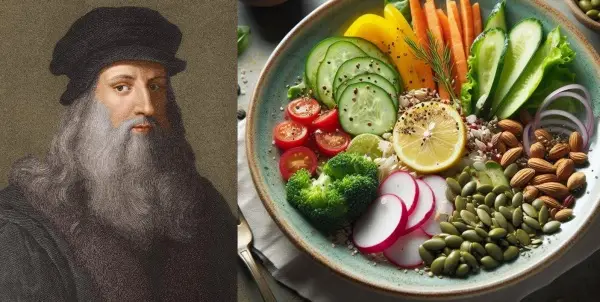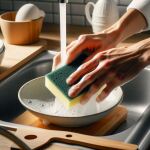Leonardo Da Vinci's diet, the secrets of his genius?
Discover Leonardo Da Vinci's healthy diet: what the genius ate and how his eating habits fueled his creativity and longevity....
Table of Contents
- The Eating Habits of Leonardo da Vinci
- A Philosophy of Life Through Food
- Culinary Innovation and Creativity in the Kitchen
- Simplicity as the Key to Health
Follow Patricia Alegsa on Pinterest!
The Eating Habits of Leonardo da Vinci
Leonardo da Vinci, the renowned icon of the Renaissance, is known for his multiple talents in art, science, and engineering. However, a less explored aspect of his life is his focus on nutrition, which reflects his constant pursuit of balance and well-being.
Although not as documented as his masterpieces, Da Vinci's diet offers a unique insight into his philosophy of life and his relationship with nature.
Research on Leonardo da Vinci's diet is primarily based on the analysis of his personal writings and various historical sources that have documented his life.
Da Vinci adopted a diet mainly based on fresh and natural foods, largely avoiding meat and preferring a diet rich in fruits, vegetables, and legumes.
Da Vinci adopted a diet mainly based on fresh and natural foods, largely avoiding meat and preferring a diet rich in fruits, vegetables, and legumes.
His interest in food was not limited to its nutritional value; he was also concerned about how these influenced the overall well-being of the body and mind.
In his notebooks, he wrote about the properties of different foods and their impact on health, demonstrating an advanced understanding for his time.
How to use the Mediterranean diet to lose weight
The choice to avoid meat consumption was not a dietary whim, but was deeply rooted in his philosophy of life and his love for nature.
How to use the Mediterranean diet to lose weight
A Philosophy of Life Through Food
The choice to avoid meat consumption was not a dietary whim, but was deeply rooted in his philosophy of life and his love for nature.
For Da Vinci, animals were not just sources of food; he firmly believed that, unlike plants, animals could feel pain. This ethical principle drove him to adopt, for much of his life, a diet that excluded meat.
His approach to diet was more than a simple health matter; it was an extension of his personal ethics and his holistic view of the world, where the connection between body, mind, and the natural environment was fundamental.
His love for nature was reflected in his refusal to kill animals, which was so evident that his contemporaries often joked that he was “incapable of killing a flea.”
His love for nature was reflected in his refusal to kill animals, which was so evident that his contemporaries often joked that he was “incapable of killing a flea.”
Additionally, he preferred to wear linen instead of wool or leather, avoiding materials that involved the death of living beings.
Da Vinci was also an innovator in the world of gastronomy. His passion for cooking led him to create utensils and concepts that, although ahead of their time, are now an essential part of everyday life.
Culinary Innovation and Creativity in the Kitchen
Da Vinci was also an innovator in the world of gastronomy. His passion for cooking led him to create utensils and concepts that, although ahead of their time, are now an essential part of everyday life.
Among his most notable inventions are the napkin and the three-pronged fork, significant improvements in the presentation and handling of food.
Additionally, he developed numerous kitchen utensils, such as a garlic press and an automatic roaster, which reflect his ingenuity and attention to detail.
Additionally, he developed numerous kitchen utensils, such as a garlic press and an automatic roaster, which reflect his ingenuity and attention to detail.
He also worked in various European courts, where he not only prepared food but organized banquets, applying his creativity to design menus that broke with the culinary traditions of the time.
Leonardo da Vinci's culinary tastes were surprisingly simple. One of his most cherished dishes was a combination of boiled spinach with an egg and small portions of mozzarella, a clear example of his inclination towards simplicity and balance in eating.
Simplicity as the Key to Health
Leonardo da Vinci's culinary tastes were surprisingly simple. One of his most cherished dishes was a combination of boiled spinach with an egg and small portions of mozzarella, a clear example of his inclination towards simplicity and balance in eating.
He also enjoyed simple recipes, such as boiled onion over mozzarella and chestnut soup, which reflect his deep understanding of flavors and his ability to create nutritious dishes.
His focus on simple and nutritious eating not only shows a Da Vinci who loved cooking, but also an advanced thinker who understood the importance of a balanced diet.
His focus on simple and nutritious eating not only shows a Da Vinci who loved cooking, but also an advanced thinker who understood the importance of a balanced diet.
Although he lived in the 15th century, many of his food choices surprisingly align with current recommendations for maintaining good health, thus anticipating the principles that govern healthy diets today.
His holistic view of life and diet, where each food choice had an impact on his health and his environment, remains relevant in today's nutrition and wellness.
Subscribe to the free weekly horoscope
Aquarius Aries Cancer Capricorn Gemini Leo Libra Pisces Sagittarius Scorpio Taurus Virgo
I am Patricia Alegsa
I have been writing horoscope and self-help articles professionally for over 20 years.
Subscribe to the free weekly horoscope
Receive weekly in your email the horoscope and our new articles on love, family, work, dreams and more news. We do NOT send spam.
Astral and numerological analysis
-
 Discover your future, secret personality traits and how to improve in love, business and life in general
Discover your future, secret personality traits and how to improve in love, business and life in general
-
 Online Dream Interpreter: with artificial intelligence
Do you want to know what a dream you had means? Discover the power of understanding your dreams with our advanced online dream interpreter using artificial intelligence that responds to you in seconds.
Online Dream Interpreter: with artificial intelligence
Do you want to know what a dream you had means? Discover the power of understanding your dreams with our advanced online dream interpreter using artificial intelligence that responds to you in seconds.

















